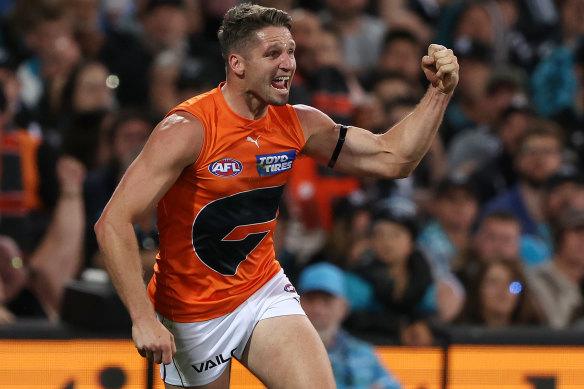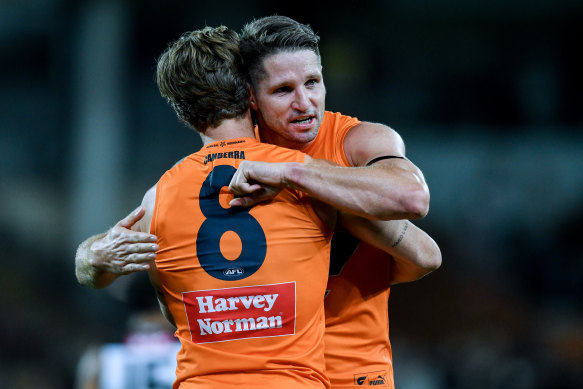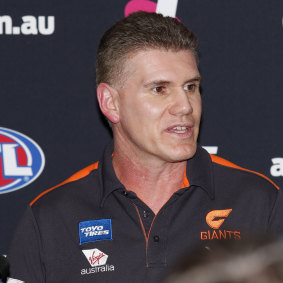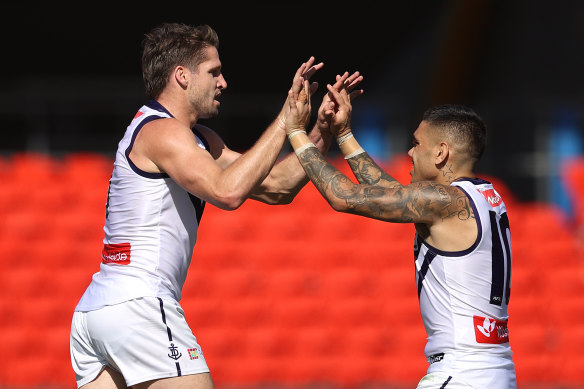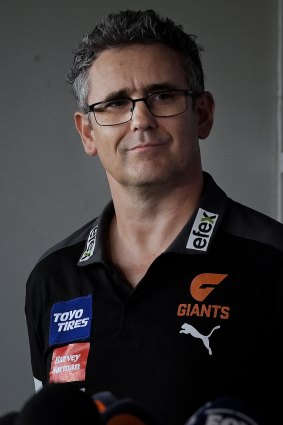Behind the scenes of Jesse Hogan’s Giant resurrection
Save articles for later
Add articles to your saved list and come back to them any time.
It took a series of unrelated events for Jesse Hogan’s resurrection as a Giant to eventuate.
There were Hogan’s off-field issues at Fremantle – ranging from a COVID-19 breach, when he invited a woman into his home instead of self-isolating, alcohol-related episodes, and ending up in hospital after his car ended up on its side – plus their inability to get his body right.
With a year still to run on Hogan’s contract, Dockers football manager Peter Bell made it clear to potential suitors at the end of the 2020 season that the once-coveted forward was available.
Jesse Hogan is a vital cog in the GWS forward line.Credit: AFL Photos
Another was Greater Western Sydney superstar Jeremy Cameron’s high-profile defection to Geelong. The Giants were under salary-cap stress and knew they needed to offload some players, but Cameron was not a player they wanted to lose.
They drafted Jake Riccardi out of the VFL with a late pick a year earlier, but Harry Himmelberg and Jeremy Finlayson were effectively their only other tall forwards with Cameron gone.
One of Hogan’s agents, Matt Bain, had relocated to Sydney and was locked in conversations with GWS football boss Jason McCartney about whether another client, Jye Caldwell, would remain a Giant (he ended up being traded to Essendon).
Then, one September day, Bain raised a new name with McCartney: “How about Jesse Hogan?”
McCartney’s interest was piqued, and he put one of their recruiters, award-winning former Age journalist Emma Quayle, on the job to do some investigative work on Hogan.
Quayle discovered a theme with Hogan’s off-field troubles, namely that he never dragged any of his teammates down with him. The other key finding?
Hogan and Callan Ward celebrate the Giants’ win over Port Adelaide.Credit: Getty Images
“It kept coming back to Jesse not being a bad person – he was a good person who had a lot of s— happen in his life,” McCartney told this masthead. “We thought he could help us, and we could help him.”
Hogan’s rocky journey
GWS were well aware of Hogan’s pedigree as a one-time junior prodigy who won the AFL’s Rising Star award in 2015 – becoming the first key forward since Nick Riewoldt 13 years earlier to do so – and kicked 152 goals in 71 games for Melbourne.
He was rated as highly as Joe Daniher in his early seasons.
Hogan, originally from Perth, requested a trade to Fremantle at the end of 2018, in a move billed at the time as the Dockers securing their missing puzzle piece, especially since Matthew Pavlich’s retirement. But there were warning signs after Hogan suffered a season-ending partial fracture of the navicular bone in his right foot.
The trade was a sliding-doors moment not only for Hogan but the Demons, who used Fremantle’s pick six – the centrepiece of the Hogan deal – to acquire Steven May from Gold Coast and stiffen their defence.
May was one of the catalysts for Melbourne’s drought-busting 2021 premiership, but Hogan and Fremantle enjoyed nowhere near the same success together, from the time he missed the season opener in his first year there, after making what Bell described as “poor choices around alcohol”.
Jesse Hogan in his time with the Demons.Credit: Getty Images
That call to leave Hogan out was wrapped around him suffering from “clinical anxiety”, an inaccurate term Bell and co. backtracked from after medical experts criticised the club.
But the hits kept coming. Hogan re-injured his navicular bone later that season in a clash with the Demons, while soft-tissue setbacks also marred his career out west, but there were greater problems away from the field.
The 28-year-old previously revealed that football fans would peer into his trolley when he was at the supermarket and question the type of food he was buying. They also whipped out their phones to film Hogan if they spotted him having a few beers at a nightspot.
His dream homecoming had turned into a nightmare.
Weighing up the risk
It is too often overlooked what Hogan went through. He lost his father, Tony, to cancer in 2017, before having surgery later that year to have a tumour removed after being diagnosed with testicular cancer.
Giants football boss Jason McCartney.Credit: AFL Photos
McCartney developed a theory after beginning to learn about Hogan’s experience in Western Australia over Zoom chats that replaced face-to-face conversations due to the COVID-19 pandemic.
Hogan’s re-emergence as a star – including kicking four goals in the Giants’ semi-final upset of Port Adelaide on Saturday night – and ability to get on top of his physical woes since relocating to the Harbour City have convinced McCartney he was right.
“I’m sure there is some level of science to it, but him being in a better place with his body, touch wood, has come about while he is a lot more at ease,” McCartney said.
“I’m incredibly happy for this young man, and the space he’s in, in his life. There is still stuff there, and he’s far from perfect, but from when he arrived, and the work he’s done and the environment we’ve provided him with at the club, he’s so much better off.”
McCartney would finish his Zoom chats with Hogan before speaking to his then-housemate, Lachie Schultz, as uncertainty about list spots reigned. Schultz ended up staying at Fremantle, at least in part because GWS were too tight in their salary cap.
But those online discussions with Hogan proved fruitful.
As the process started heading towards Hogan becoming a Giant, then-coach Leon Cameron and senior players Toby Greene, Callan Ward and Phil Davis started talking to him, too.
Hogan (left) with Michael Walters before the key forward was traded from Fremantle.Credit: Getty Images
Stephen Coniglio and Matt de Boer also caught up with Hogan during the off-season while they were back in Perth. Some at GWS were more cautious about recruiting Hogan, but there was enough belief they could turn his career around.
“Maybe there was some risk associated, but we did the work to justify recruiting Jesse,” McCartney said.
Fremantle agreed to trade Hogan for a third-round pick, while the big forward signed an incentivised one-year, prove-it deal with the Giants.
How the giants fixed Hogan
McCartney and Cameron figured out enough about Hogan throughout the recruiting process to know tough love was not the way to bring out the best in him.
They also got the impression that he realised, without saying it aloud, that he was an unfulfilled talent.
Former GWS Giants coach Leon Cameron.Credit: Kate Geraghty
GWS organised for Hogan to live in a humble granny flat at the back of Shane Mumford’s property as a short-term option, but he ended up enjoying the arrangement so much that he stayed for about a year.
Having Bain in Sydney as a trusted confidante and extra layer of support was also an ideal scenario for Hogan, after he met several other clubs, including Richmond, the Swans, and his old club Melbourne.
“I knew the [Giants’] group pretty intimately from having a few of their players as clients, so I knew he’d fit in really well, mixed in with the lifestyle Sydney has to offer, with the surfing and being out of the spotlight,” Bain said.
“It was the perfect fit for him to get away from the prying eyes of everyone, and it was important for him to get a fresh start to get his body right. But he was under no illusions that this was likely his last chance. I’ve been through everything with him, so to see him progress the last few years has made me immensely proud.”
One of the first steps was plotting a plan for him to get his body right, and GWS’ head of high performance, Nick Poulos, prioritised winning Hogan’s trust.
They were conservative with his pre-season program, but a quad injury ruined his hopes of a round one debut. It was not his only setback either, and Hogan played only nine games in that first season – but the Giants were encouraged.
He booted 20 goals in those matches, including 2.2 and six contested marks in a “phenomenal” performance in the one-point elimination final win over the Swans. A calf injury prevented Hogan from playing the next week.
“Leon was very good with him. There were moments of frustration with his injuries, or from him not chasing to lay a tackle out of our forward line, for example, but Leon was smart,” McCartney said.
“He would talk to him about fixing a couple of things with his game, or at training, but always coming from a great place of support. Jesse just needed some love.”
Last year, the Giants and Hogan set a goal – to play 18 matches, with periodic rests built in. By playing in round 23, Hogan achieved just that – and his three goals that day gave him 35 for the season, his most since kicking 47 in his final season at Melbourne.
Free of restrictions, he has been a model of consistency in 2023. Hogan has kicked multiple goals in 15 of his 22 matches, with a career-best nine against Essendon reminding everyone what he is capable of.
His four-goal haul last week set a new personal high of 48 for the season, and he looms as a major factor in whether GWS can topple minor premiers Collingwood on Friday night to reach their second grand final.
“We’re rapt with his season. He obviously had the nine-goal bag, but that was just reward for some other games where he played a really important part, and kicked his couple,” McCartney said.
“He competes so well in the air and is not outmarked often, which is what you want, with guys like [Brent] Daniels and [Toby] Bedford down there. Toby [Greene] loves playing with him because he has elite forward craft and knowledge – he’s been so good for us.”
Keep up to date with the best AFL coverage in the country. Sign up for the Real Footy newsletter.
Most Viewed in Sport
From our partners
Source: Read Full Article
